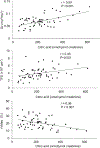Urine metabolites are associated with glomerular lesions in type 2 diabetes
- PMID: 30830355
- PMCID: PMC6461445
- DOI: 10.1007/s11306-018-1380-6
Urine metabolites are associated with glomerular lesions in type 2 diabetes
Abstract
Introduction: Little is known about the association of urine metabolites with structural lesions in persons with diabetes.
Objectives: We examined the relationship between 12 urine metabolites and kidney structure in American Indians with type 2 diabetes.
Methods: Data were from a 6-year clinical trial that assessed renoprotective efficacy of losartan, and included a kidney biopsy at the end of the treatment period. Metabolites were measured in urine samples collected within a median of 6.5 months before the research biopsy. Associations of the creatinine-adjusted urine metabolites with kidney structural variables were examined by Pearson's correlations and multivariable linear regression after adjustment for age, sex, diabetes duration, hemoglobin A1c, mean arterial pressure, glomerular filtration rate (iothalamate), and losartan treatment.
Results: Participants (n = 62, mean age 45 ± 10 years) had mean ± standard deviation glomerular filtration rate of 137 ± 50 ml/min and median (interquartile range) urine albumin:creatinine ratio of 34 (14-85) mg/g near the time of the biopsy. Urine aconitic and glycolic acids correlated positively with glomerular filtration surface density (partial r = 0.29, P = 0.030 and r = 0.50, P < 0.001) and total filtration surface per glomerulus (partial r = 0.32, P = 0.019 and r = 0.43, P = 0.001). 2-ethyl 3-OH propionate correlated positively with the percentage of fenestrated endothelium (partial r = 0.32, P = 0.019). Citric acid correlated negatively with mesangial fractional volume (partial r=-0.36, P = 0.007), and homovanillic acid correlated negatively with podocyte foot process width (partial r=-0.31, P = 0.022).
Conclusions: Alterations of urine metabolites may associate with early glomerular lesions in diabetic kidney disease.
Keywords: Biomarkers; Kidney structure; Metabolites; Type 2 Diabetes.
Conflict of interest statement
Compliance with ethical standards
Conflict of interest Pierre-Jean Saulnier, Manjula Darshi, Kevin M. Wheelock, Helen C. Looker, Gudeta D. Fufaa, William C. Knowler, E. Jennifer Weil, Stephanie K. Tanamas, Kevin V. Lemley, Rintaro Saito, Loki Natarajan, Robert G. Nelson, and Kumar Sharma declare that they have no conflict of interest.
Figures

References
-
- Beger RD, Holland RD, Sun J, Schnackenberg LK, Moore PC, Dent CL, et al. (2008). Metabonomics of acute kidney injury in children after cardiac surgery. Pediatric Nephrology, 23, 977–984. - PubMed
-
- Belsley DA, Kuh E, & Welsch RE (1980). Regression Diagnostics: Identifying Influential Observations and Sources of Collinearity Hoboken: John Wiley and Sons.
-
- de Cavanagh EM, Inserra F, & Ferder L (2011). Angiotensin II blockade: A strategy to slow ageing by protecting mitochondria? Cardiovascular Research, 89, 31–40. - PubMed
Publication types
MeSH terms
Substances
Grants and funding
LinkOut - more resources
Full Text Sources
Medical
